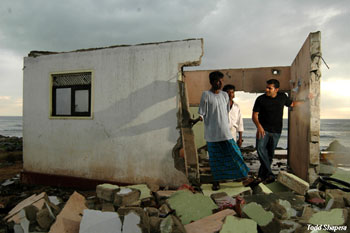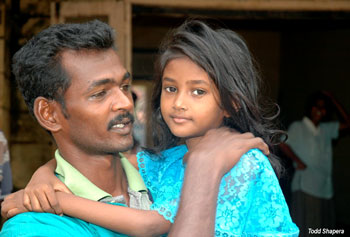 |
 | ||||||||||
A Second Wave
February 2005
|
 |
|||||||||
|
Six years ago, I stumbled upon Sri Lanka in an unlikely way, at thirty-five thousand feet over the Pacific. Our Singapore Airline's pilot from San Francisco, clad in a jogging suit after a nap, took a seat near me in business class and asked for a breakfast tray. I asked if I could join him. Capt. Elmo Jayawardena greeted me with a warm smile. When he isn't flying four hundred passengers on 747s to Amsterdam or Dubai, there's philanthropy to look after in Sri Lanka with his wife Dil. They founded The Association For Lighting A Candle (AFLAC) to assist needy families. "We try to be the link between one person's generosity and another person's humanitarian need," he explained. After some time, Elmo tapped my tray: "My friend, I must go land the plane." Before he could leave, I had a final question. When my Singapore work was completed in a few days, where might I travel in Asia that would be special? Elmo paused, briefly. "Why don't you come to Sri Lanka? I'll show you AFLAC's programs," he offered. My four day visit to Elmo and Dil's river house south of Colombo was special. They feted me, taught me to eat curried vegetables and rice with my right hand, and drove me all over to observe and photograph their many programs. I wrote about their work in several magazines. Over the years, we remained in touch. So when the Tsunami hit, I felt a personal connection to Sri Lanka. And as a photojournalist, I felt that AFLAC might give me entree to documenting the aftermath in an intimate, unobtrusive way. Elmo invited me to join his son Mevan, 25, as he coordinated AFLAC's response. Within days, I cleared my schedule, coordinated care for my daughter, and was packed for Sri Lanka with a loaner D70 camera from Nikon -- my first serious foray into digital. I also had emailed many of many of my photography clients about AFLAC. Many valued the idea of giving to a local relief agency and brought me donation checks in the few days for AFLAC before I departed. Mevan met me at the Colombo airport. Riding home, he told me that after the second tsunami wave, he ran a mile or so to the beach. By then, all the homes along the water were destroyed -- a nighmarish site. Two days later, he searched in vain for the body of his sister's groomsman on a southern beach. He knew then he couldn't return to his IT job in Australia -- at least not right away.
We drove across the girth of the island to the city of Batticola on the east coast. We passed through highlands with wild elephants and monkeys, and ancient cities. Then we entered a border area dominated by ethnic Tamils, a region of bloody guerrilla warfare for a decade. Now, there is a tenuous ceasefire. The last 90 miles or so were on unpaved roads, with army bases everywhere and checkpoints sometimes every kilometer. There were signs in grass fields bordering the road warning of land mines. At one point, a soldier with a rifle got in our car for a drive up a dirt road to a series of camps. He told us that, before the military arrived, the LTTE rebels had kidnapped Tsunami surviving children from survivor camps for their army. When the soldier got in our car, I got out, fearing we'd become a target. Mevan suggested that the friendly rifleman would help us get through the many checkpoints ahead; I got back in. He guided us to the remote fishing village of Mankenyia that had been prosperous enough before the Tsunami to have built a solid stone church 1,000 yards or so from the sea. The church's entrance door was an ornate fish mouth that swallowed up believers as they entered to pray. On the sunny Sunday morning of the Tsunami, the minister was late for service. This saved his flock. They were inside praying when the waves washed away their village. Nearly everyone else, and every structure on the flat land, vanished, including a military base. Understandably, survivors in the church (and elsewhere) felt blessed by divine intervention. On a back porch of the church, a few women were cooking on the ground, their pots heated by a few coals. One lady put her arm around a boy. His mother was her sister, and was lost to the sea. The aunt smiled lovingly and told me she would raise him now. As I photographed them, I wondered what to make of their smiling. Surely, few editors would consider this a credible representation of survivors and their trauma. But, often when talking to people in camps, and photographing them, they eventually smiled in a natural way.
A priest told me that another help in coping was that survivors sheltered in his church buildings freely related their stories among each other -- forming their own self-help groups. This seemed to be different from Holocaust survivors who often clammed up for a lifetime. Perhaps there is a difference between surviving a natural disaster and a genocide.
Throughout our journey, I was struck by the gentleness of Sri Lankans, even in harsh places. I found myself trying to capture this quality in my photographs -- their faces, their body language, and their interactions. It often seemed enhanced by soft light from an overhead window. Over time, I grew to accept that some Tsunami survivors have reason enough to smile, at least some of the time. For they still have their lives, their resilience, and their bonds to each other.
© Todd Shapera
Dispatches are brought to you by Canon. Send Canon a message of thanks. |
||||||||||
Back to February 2005 Dispatches
|
|



